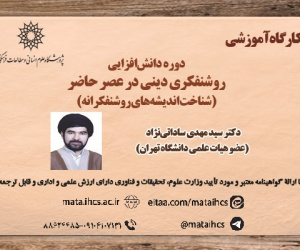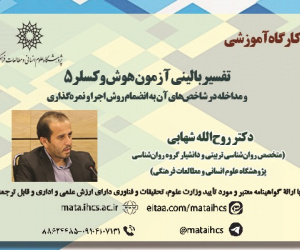نشانه شناسی سفره طباخی صوفیه براساس اهمّ متون تعلیمی تصوف از قرن چهارم تا قرن هشتم (مقاله علمی وزارت علوم)
درجه علمی: نشریه علمی (وزارت علوم)
آرشیو
چکیده
از دیدگاه علم نشانه شناسی، هر متن ادبی و نیز هر حوزه از فرهنگ بشری، دستگاهی از نشانه هاست که به معانی ای فراتر از معنای قاموسی خود دلالت می کنند. بر اساس این، سفره صوفیه و نوع، شکل و اندازه غذاها واجد نظامی از نشانه هاست. ازآنجا که روزه، جوع و پرهیز از شکم بارگی از ارکان اصلی تصوف هستند، انواع طعام و نوشیدنی ها ارزش نشانه شناختی دارند. به همین دلیل، پژوهش در فرهنگ غذایی صوفیه و نشانه شناسی غذاها در سفره صوفیه، دریچه ای است به سوی درک جهان تصوف. پژوهش مذکور نشان می دهد که بر خلاف اهمیت بنیادین روزه داری و پرهیز از خوراک در تصوف، ژانر تعلیمی نسبت به ژانرهای دیگر ادبی، از لحاظ نوع، بسامد و پرداختن به انواع غذاها و رنگینی سفره، بسیار غنی و درخور توجه است. بی شک، دلیل اصلی آن می تواند عمل گرایی رسالات تعلیمی صوفیه و توجه آنان به زندگی روزمره عامه مردم باشد. دیگر اینکه، در سفره صوفیه، غذاها، حلویات و نوشیدنی ها در جدول سلسله مراتبی و دقیقاً معکوس سلسله مراتب ارزش عمومی قرار می گیرند. این سلسله مراتب باعث می شود که غذاها به حوزه معنویت وارد شوند و ارزشی نشانه ای و نمادین پیدا کنند. پرداختن به این جنبه بسیار مهم است؛ زیرا خوردنی ها و نوشیدنی ها بنابر مواد خود، داوریِ ارزشی می شوند. بدیهی است که مزه و طعم نیز به چنین جدولی وارد می شود. هم ارزی «غذا»، «معنویت» و «جایگاه اجتماعی» می تواند سنجه ای برای ارزیابی رانه های ارزشی- اجتماعی و نیز تبیین بسیاری از ضرب المثل های حوزه غذا، در اختیار پژوهشگران قرار دهد. مقاله حاضر می کوشد تا با ارجاع به اولیانامه ها و رسالات تعلیمی از این روزنه به دنیای معنوی صوفیه بپردازد.The Semiotics of Sufiya's Table: An Analysis of Key Didactic Texts in Sufism from the 4th to 8th Centuries
From the perspective of semiotics, every literary text and aspect of human culture functions as a system of signs, conveying meanings that extend beyond their literal interpretations. In this context, Sufia’s table—along with the type, shape, and size of the food—embodies a multitude of signs. Given that fasting and avoidance of gluttony are foundational principles of Sufism, all forms of food and drink possess a semiotic value. Thus, the semiotics of the food on their table serves as a gateway to understanding the world of Sufism. This research demonstrated that, despite the central importance of fasting in Sufism, the didactic genre, in particular, offered a rich exploration of various types of food more so than other genres. This richness could be attributed to Sufia’s pragmatism and focused on the daily lives of people. Moreover, the arrangement of foods on the Sufi table followed a hierarchical structure that was the exact inverse of conventional value hierarchies, allowing these foods to transcend mere sustenance and acquire spiritual significance. It was essential to examine this aspect, as food and drink were valued according to their ingredients, with taste also playing a critical role in this hierarchy. The equivalence of "food", "spirituality", and "social position" provided researchers with a framework to assess social values and elucidated many proverbs related to food. This article aimed to illuminate the spiritual dimensions of Sufism through this lens.
Keywords: Sufism, Semiotics, Food, Sufia’s Table.
Introduction
According to semiotic theory, we inhabit a world of signs—encompassing signposts, photographs, notices, and literature. Each literary genre establishes its own semiotic framework so that upon entering a textual semiotic system, every phenomenon adopts the specific "signification", "approach", and "meaning" inherent to that system. Food is no exception to this process. Once introduced into a literary text, food cannot maintain its individual meaning outside the context of the genre in which it appears. For instance, in the epic literary genre, food carries connotations of glory and ceremony, while in lyrical works, food and the dining table take on imaginative and fantastical qualities. In Sufi literature, which is a prominent subset of didactic literature, food is arranged within a hierarchical system, each item possessing its own distinct meanings and significance. Within this spectrum, foods are categorized from excellent to ordinary determined by their ingredients, availability in the local climate, and their nutritional value. A diverse array of foods can be classified using various codes, including softness, dryness, greasiness, taste, cost, and abundance or scarcity. Each food item not only represents its tangible existence, but also serves as a signifier of deeper spiritual, social, religious, and conceptual values that extend beyond the food itself.
Material & Methods
This research employed a descriptive-analytical approach and archival study methodology to investigate the dining table in Sufia's didactic works. The methodology consisted of the following steps:
Examination of Didactic Treatises and Textbooks: A thorough review of relevant didactic literature
Extraction of Food and Drink Types: Identifying various types of food and drink along with their frequency of occurrence
Semiotic Analysis of Food: Analyzing different types of food through the lens of semiotic theory
Hierarchical and Value Analysis: Evaluating Sufia’s table hierarchically based on codes related to taste, softness and dryness, cost, and concentration versus dilution.
Interpretation of Spiritual Codes: Interpreting the spiritual significance and value of foods in relation to sociological, populist, and spiritual-ideological beliefs, particularly those rooted in monastic traditions.
Research Findings
Human Body as an Alchemy Workshop:
In the Sufi ideological framework, humans were viewed as dual beings, with the body representing the animalistic aspect of existence that was intimately connected to the "spirit". Nurturing the body in this context could weaken the soul. The body was likened to an alchemical workshop composed of mortal, tangible materials, yet ultimately aimed at nurturing the soul, which was subtle and invisible. The organs within the human stomach functioned as alchemical tools—akin to aludel and alembic—that facilitated the education of the soul. Thus, controlling the type and source of food consumed in the material world became a means of accessing this alchemy of the soul.
The Opposition between Satiety and Hunger:
The hierarchical evaluation of food in Sufism stood in stark contrast to that of the material world. In Sufi semiotics, foods that were rarer, more energizing, tastier, and more expensive were considered less valuable, while simpler, cheaper foods held greater significance. Sufism posited that evaluation was based on hunger rather than satiety; the more pleasurable a food was to the body, the more detrimental it was deemed to the soul. In this view, hunger served to purify the inner self. Sufi treatises meticulously specified even the quantity of bread (measured in bites) and incorporated precise calculations regarding meal types and amounts.
Softness and Dryness:
The essence of the spiritual journey (Seyr-o Suluk) in Sufism involved overcoming pleasure and desire. Consequently, in Sufi food hierarchy, soft and rich foods were ranked at the bottom, while dry and austere foods occupied the top position. Simple, dry oaten bread was highly regarded as a primary sustenance. Luscious foods were viewed negatively, often associated with indulgence. From the Sufi perspective, the semiotics of soft and rich foods could even evoke sexual symbols. A Sufi aspirant on the path of Suluk was expected to consume dry and coarse foods to learn "Tariqa" (a spiritual path in Sufism).
The Semiotics of Tastes:
Beyond ingredients, taste played a crucial role in Sufi food philosophy. Sufi thought categorized tastes along a spectrum, where "sweetness" was considered the most pleasurable for the body, while "bitterness" occupied the opposite end with salty and sour tastes positioned between the two. In this inverted value hierarchy, sweetness was deemed base, whereas bitterness was seen as awakening the soul—a quality of great interest to Sufis. Salt, a staple on the table, enhanced camaraderie among those gathered and was often recommended during periods of seclusion. The sour taste symbolized by vinegar in Sufi symbology represented a "halal" limit, transitioning from forbidden wine to permissible vinegar. Consequently, vinegar was positioned in opposition to wine and combinations like bread and vinegar or bread and salt signified simplicity in Sufi cuisine. At the end of this spectrum lay the "sweet" taste, which was the most condemned and derided by Sufis.
Diversity and Frequency: A Scaled Hierarchy
From a semiotic perspective, the diversity of food on Sufia's table was also arranged in a hierarchical pyramid. This vertical structure was fundamentally opposed to conventional value systems; the simpler, more accessible, and less nutritious the food, the higher its status in the hierarchy. At the pinnacle of this pyramid was plain bread, symbolizing profound faith, devotion, and reliance. Conversely, at the base of the evaluation pyramid were roast meat and fatty kebabs, which symbolized gluttony, greed, worldliness, and undesirable traits.
Discussion of Results & Conclusion
At first glance, the Sufi emphasis on simplicity and moderation in food consumption might suggest that their doctrines overlooked the significance of food, cooking methods, and the variety of dishes. However, a closer examination of Sufi treatises, which formed a crucial part of didactic literature, revealed a rich and diverse culinary landscape. This richness stemmed from the fact that didactic texts were designed for a public audience and food was an essential element of daily life. By comparing the diversity of food and the attitudes toward it across three genres—epic, lyrical, and didactic literature—it became evident that Sufism allocated considerable attention to the spirituality associated with food. Additionally, the meticulous focus on ingredients and cooking methods in Sufi educational works highlighted their commitment to the finer details of daily life. Notably, the emphasis on the names and characteristics of various foods within these treatises could contribute to the historical understanding of Iranian cuisine and clarify its qualities for researchers in the field. Overall, this analysis underscored the importance of food in Sufi thought and its broader implications for understanding cultural and spiritual values.







